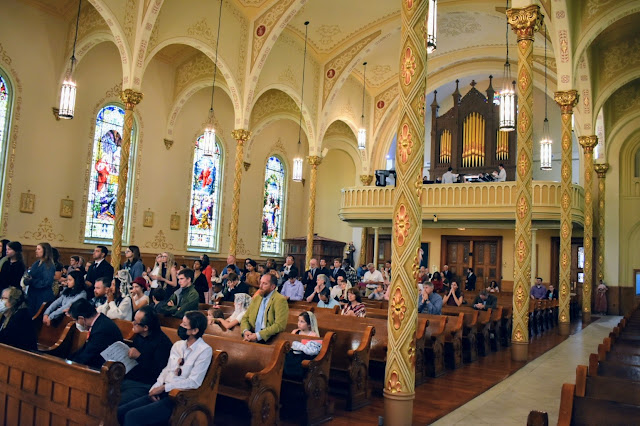It still gives me chills to see the ancient order of the Latin Mass celebrated in my former parish, the Church of the Most Holy Trinity in Augusta. This one was for October. When we restored the church around 1997 or so, we readjusted the historic altar so that Mass could be celebrated either facing the nave or facing the apse (which is the symbol for the liturgical east). I thought, then, the the revised Mass after Vatican II might one day be celebrated eastward or ad orientem never thinking the ancient order of the Latin Mass would be celebrated there regularly. Congratulations to Fr. Jacob Almeter pastor there and from Augusta also. Look at all the young people and all the altar boys. This form of the Mass seems to produce more vocations to the priesthood and religious life than the newer form. I wonder why?















7 comments:
Nice pictures of believing Catholics
Father:
Couldn't help but notice that you referred to the Novus Ordo as the "revised Mass after Vatican II". Great! I commend your progress, since we can be certain from the preponderance of evidence that it certainly is NOT the "Mass OF Vatican II", nor is it the Mass that Vatican II called for and it definitely isn't "reformed".
In the spirit of precise language--which our poor world and, especially our Church could use more of--I have. a few other suggestions for appropriate terminology for the current rite that is preferred by our pope. You can use the terms "rite" and "form" interchangeably:
The Contrived Rite
The Imposed Rite
The Rite by Committee
The Masonically-Inspired Rite
The Less Than 20 Percent Rite
The Managed-Decline Rite
The "Why Convert?" Rite
The Pastiche Rite
and my current favorite, The Pyrrhic Victory Rite
Language has such great power to impart reality when used with exacting precision. It can also distort reality, as we have seen since 1970, since anyone with an IQ over 60 can figure out that the New Mass certainly didn't reform anything and as a part of the "New Evangelization", it has led to a decline of faith and belief heretofore unprecedented in any major religion.
Hey! I just came up with another more precise term:
The Failed Evangelism.
The Church of the Most Holy Trinity in Augusta was established in 1810 on its current property. Prior to that in the late 1700’s priests visited Augusta to offer Mass in homes most for the French Catholics who were there. It has a colorful history and was a big part of the “trustee system of the 1860’s that was a cause of crisis in American Catholic History. The pastor who built the “new” church (the current one) also went on the become the second bishop of Savannah. He is buried under the church’s main altar. He has a colorful history as does the conflict between the original French Catholics there and the Irish who in the 1840’s eclipsed the French in number and power. Father and then Bishop Barry had an affinity and empathy for the French who were being marginalized in their own parish by the Irish. Thus when he laid the cornerstone for the new Church, even though the official name was Most Holy Trinity, he dedicated it to the French saint, Saint Vincent DePaul. Unfortunately Bishop Barry died in Paris before the church was completed and on Easter Sunday, 1863, a week after its dedication the Irish clergy there along with the predominantly Irish laity voted to have Saint Patrick as their patron saint and then began to call the new church St. Patrick rather than Most Holy Trinity which was and always was its official name. Saint Patrick remained its popular name until 1970 when two other churches in downtown Augusta were closed and merged with St. Patrick at which time the official name returned to the church. We discover buried behind the church as we did construction on a new sacristy a very tall, cast iron statue. The construction workers dug it up for us to find out which saint it represented. It, keep in mind made of cast iron, had been crushed and then buried. IT WAS SAINT VINCENT DEPAUL!
Jerome Merwick,
Bravo - every bishop should see your post!
Father McDonald,
You will be pleased that today, St. Joseph Church in Macon was a featured church in the October photofest at The New Liturgical Movement.
I saw that and the horrible altar cloths acquired since my delay as the ones I acquired and presumably still there are far more appropriate and tasteful! But I am still waiting for them to post the stunning photos from my other former parish in Augusta, the most recent ones with alter clothes I acquired in the 1990’s!
My departure not delay damn that autocorrect
Post a Comment